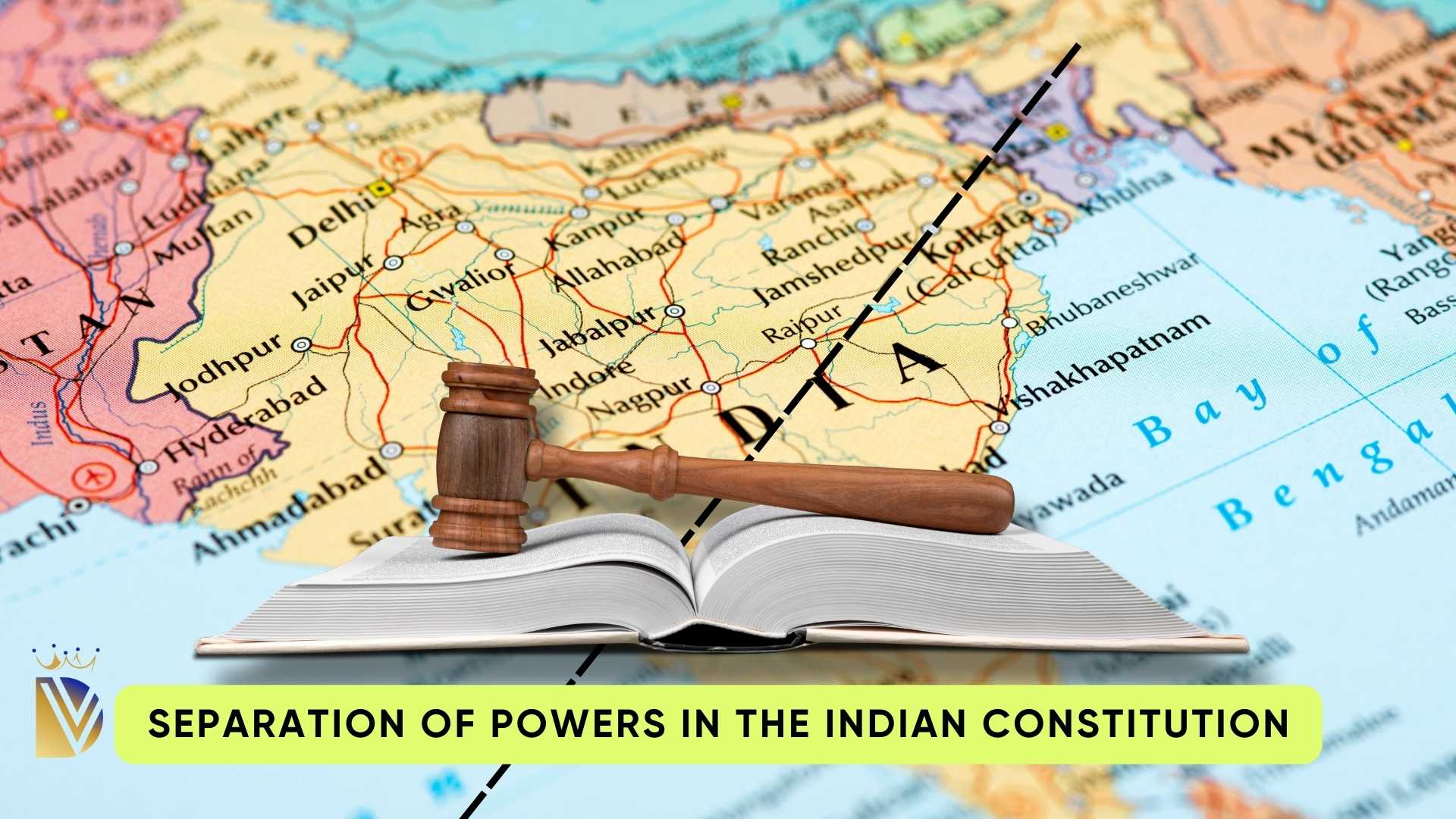The concept of separation of powers is a foundational principle in the Indian Constitution, shaping the distribution of authority among the executive, legislative, and judicial branches. This article explores how the Indian Constitution enforces and maintains the separation of powers, ensuring a system of checks and balances.
Three Organs of Government
- Legislature: The legislature’s primary role is lawmaking, serving as the foundation for the executive and judiciary. It holds a central position, as the enactment of laws is crucial for their implementation.
- Executive: The executive executes laws and oversees the administration of the government. Comprising ministers, including the Prime/Chief Ministers and President/Governors, it is the administrative head of the government.
- Judiciary: Responsible for interpreting laws, settling disputes, and administering justice, the judiciary is the guardian of the Constitution. It encompasses the Supreme Court, High Courts, and subordinate courts.
Separation of Powers:
- Concept Background: The doctrine traces back to Aristotle in the 4th century BCE, evolved in the Ancient Roman Republic, and was systematized by Montesquieu in the 18th century. John Locke further contributed to its development.
- Purpose: The separation of powers aims to prevent the abuse of power, ensuring a check against tyranny. By allocating specific functions to distinct branches, it safeguards freedom and promotes effective governance.
Understanding Separation of Powers
Separation of powers divides the governance mechanism into three branches: Legislature, Executive, and the Judiciary. While various authors may offer distinct definitions, three fundamental features characterize this doctrine.
- Distinct Personnel:
Each organ should comprise different individuals. Those with roles in one organ should not participate in another.
- Non-Interference:
Organs should refrain from meddling in the functions of others.
- Mandate Adherence:
Each organ should adhere strictly to its designated functions, refraining from assuming the roles of others.
These broad delineations exist, yet in a complex nation like India, conflicts and transgressions between branches often arise.
Significance of the Doctrine
This principle serves as a bulwark against the encroachment of autocracy into a democratic system. Its importance can be succinctly articulated as follows:
- Prevention of Autocracy:
Acts as a deterrent, preventing the infiltration of autocratic tendencies into democratic governance.
- Safeguarding Individual Liberty:
Protects citizens from arbitrary rule, preserving their individual liberties.
- Efficient Administration:
Contributes to the establishment of an efficient administrative framework.
- Preserving Judiciary’s Independence:
Upholds the independence of the judiciary, a critical aspect of a functioning democracy.
- Preventing Arbitrary Legislation:
Acts as a check, preventing the legislature from promulgating arbitrary or unconstitutional laws.
In essence, the Separation of Powers doctrine plays a pivotal role in maintaining the democratic fabric, ensuring a balanced and accountable governance structure.
Constitutional Framework of Separation of Powers in India
Branches of Government:
Under the Indian Constitution, the government is organized into three branches:
- Legislature: Comprising Parliament (Lok Sabha and Rajya Sabha) and State legislative bodies.
- Executive: Led by the President at the central level and Governors at the state level.
- Judiciary: Encompassing the Supreme Court, High Courts, and all subordinate courts.
Key Constitutional Articles:
Several constitutional articles define and regulate the separation of powers:
- Article 50: Places an obligation on the State to separate the judiciary from the executive. However, being part of the Directive Principles of State Policy, it is not enforceable.
- Articles 53 and 154: Vest executive power in the President and Governors, granting them immunity from civil and criminal liability.
- Articles 121 and 211: Prohibit legislatures from discussing the conduct of judges except in cases of impeachment.
- Article 123: Empowers the President to exercise legislative powers by promulgating ordinances under certain conditions.
- Article 361: Grants immunity from court proceedings to the President and Governors for the exercise of their powers and duties.
Checks and Balances:
The system incorporates checks and balances to prevent any one organ from becoming excessively powerful:
- Judicial Review: The judiciary holds the power of judicial review over executive and legislative actions, ensuring their constitutionality.
- Legislative Oversight: The legislature reviews the functioning of the executive, altering judgments within constitutional limits.
- Appointment Mechanism: While the judiciary is independent, judges are appointed by the executive, maintaining a delicate balance.
Functional Overlap:
Despite separation, functional overlap exists:
- The legislature exercises judicial powers in cases of breach of privilege, impeachment, and removal of judges.
- The executive influences the judiciary through appointments to key positions.
- Legislative powers are invoked to amend laws declared ultra vires by the court.
- The legislature, while discharging its functions, also performs judicial roles.
- Legislative powers allow punishment for exceeding freedom of speech, subject to due process.
- The executive, integral to the legislature, can exercise legislative powers through ordinances.
- Tribunals and quasi-judicial bodies within the executive perform judicial functions.
Challenges and Constitutional Limitations:
The Indian system lacks a strict separation of personnel, relying on constitutional limitations and trust to prevent abuse of power. The Constitution establishes a system of checks and balances, vital for a just and equitable functioning of the constitutional framework.
In essence, the Indian Constitution creates a dynamic system where organs possess both exclusive and overlapping powers, ensuring a nuanced approach to governance without absolute separation of functions.
Landmark Judicial Decisions Shaping Constitutional Governance
Kesavananda Bharati v State of Kerala (1973):
In this pivotal case, the Supreme Court asserted that the Parliament’s amending power is not absolute and is subject to the basic features of the Constitution. Any amendment contravening these fundamental aspects would be deemed unconstitutional.
Swaran Singh Case (1998):
In this instance, the Supreme Court declared the pardon granted by the Governor of Uttar Pradesh to a convict as unconstitutional. This decision underscored the limits on executive clemency powers.
Ram Jawaya Kapoor V State of Punjab (1955):
This landmark case clarified that while the Indian Constitution doesn’t strictly adhere to the doctrine of separation of powers in its absolute rigidity, it adequately distinguishes and differentiates the functions of various branches of the government. The Constitution discourages any organ from assuming functions inherently belonging to another.
Indira Nehru Gandhi v. Raj Narain (1975):
In a case involving a dispute over the election of the Prime Minister, the Supreme Court emphasized that the adjudication of specific disputes is a judicial function. Even under constitutional amending power, Parliament cannot perform this judicial function. The judgment highlighted the importance of maintaining a clear separation between the legislative and judicial spheres in the Indian context.
These judicial pronouncements collectively contribute to defining the boundaries and principles that guide the functioning of the organs of the state, ensuring a delicate balance and adherence to constitutional norms.
Conclusion:
The separation of powers in the Indian Constitution is a carefully crafted mechanism designed to ensure that no single branch dominates, promoting a balance of power and safeguarding the rights and freedoms of citizens. As India progresses, upholding the principles of this separation becomes crucial for the continued success of its democratic system.










